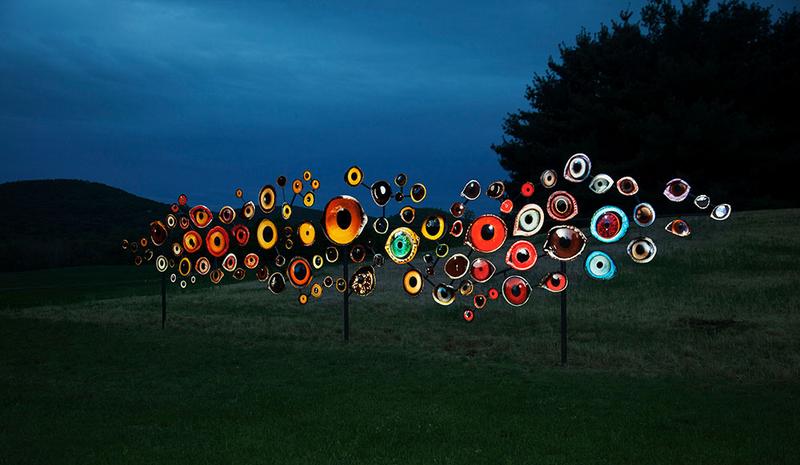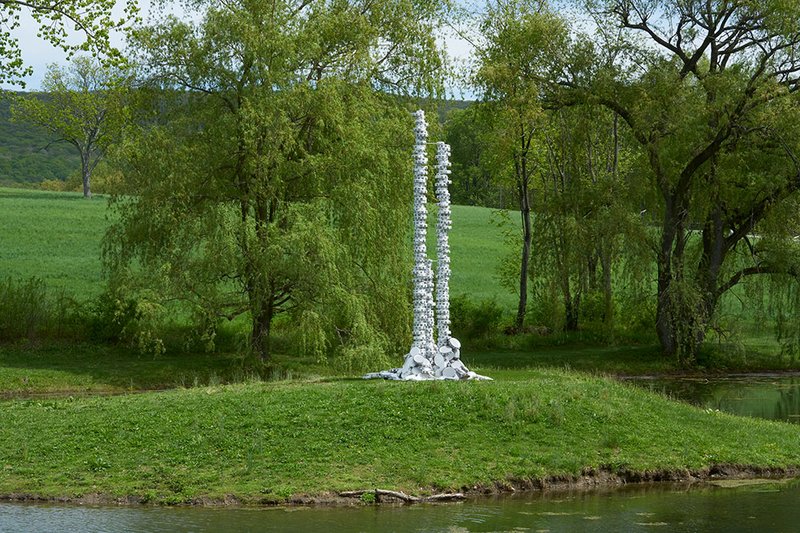
Climate change is both terrifyingly real and, at the same time, notably abstract. We know it's altering the world around us, but it can be hard to comprehend the subtle changes in weather patterns and how they are affecting the planet and society.
The Storm King Art Center is trying to address that challenge through a new exhibition, “Indicators: Artists on Climate Change.” The show features work by 16 artists and one art collective who use different approaches, from the scientific to the personal, from the confrontational to the conceptual, to examine changing climate. Some of the works are on view inside Storm King’s main building while many others were made specifically for the sculpture park and are installed throughout the site’s 500 acres.
The artists include Maya Lin, Meg Webster, Justin Brice Guariglia, Mary Mattingly and Mark Dion (here’s the full list.)
One site-specific work is “Birds Watching” by Jenny Kendler. It consists of close ups of birds’ eyes of different shapes and sizes made from of the same material used to create reflective street signs. Some eyes are yellow, others red, green or white, and in each one, a dark pupil ranging in size from pinpricks to wildly dilated sit in the center. Kendler based her work on bird species considered to be threatened due to climate change, according to recent research by the Audubon Society. As you stand there before the eyes, you are bird watching, but they are also watching you, and in their unblinking stare ask, “What are you doing about our future?”
Another more conceptual work on view is by David Brooks which probes the concepts of time in a changing climate. In his "Permanent Field Observations," Brooks explored Storm King and found 30 objects such as pieces of wood, bone, and roots, and then made bronze replicas of them. He then placed his copy next to the original item where he found it. As the authentic item changes and decays over time – perhaps even disappears – the bronze cast remains as a physical memory to another time.
One reason why “seeing” the consequences of climate change can be difficult is due to our own inability to grasp time that stretches into decades and centuries and even longer from now. The day-to-day is what we see most easily (and nowadays, more often, it’s tweet-to-tweet), that it’s hard to act for a future we may not even be alive to experience. Brooks’ works leads you to search in the woods to find his bronze casts and the originals and, in the process, consider the flow of time.
The sculptures also address how climate change is influencing society. Allison Janae Hamilton focuses on the interaction of nature and society. “I was really interested in how communities grapple with the aftereffects of natural disasters and how they become social disasters where they really illuminate some already existing disparities socially.”
Her work consists of three pillars of white tambourines, two tall ones and one one smaller one, on an island in a pond at Storm King. Called “The peo-ple cried mer-cy in the storm,” the towers resemble sentries – perhaps a man, woman and child – standing quietly amid the trees and the lush green grass. The title comes from the song “Florida Storm,” written about two hurricanes in Florida in the 1920s, one of which killed thousands of black migrant workers. The work is mournful and solemn, and also infused with spirituality, saying to us that even in the face of disaster, we are still standing.
Taken as a whole, it is an exhibition that fits with the vision of art and nature that come together at Storm King, where it is much about sculptures as it is environmental stewardship and preserving the land as a work of art in and of itself.
For even more photos, check out Sai Mokhtari’s pictures over at Gothamist.
And click here for directions on how to get to Storm King by bus, car or train.

